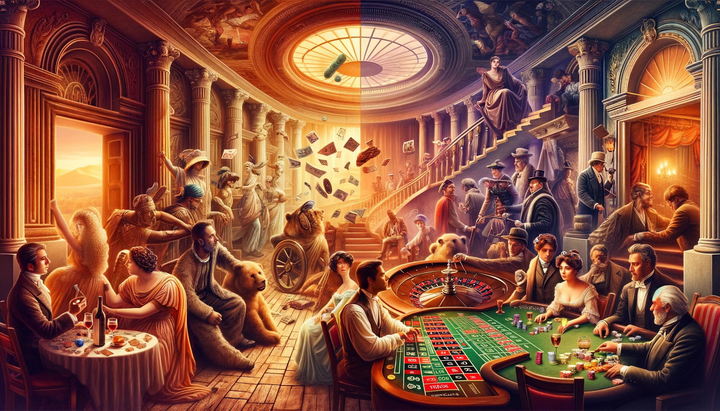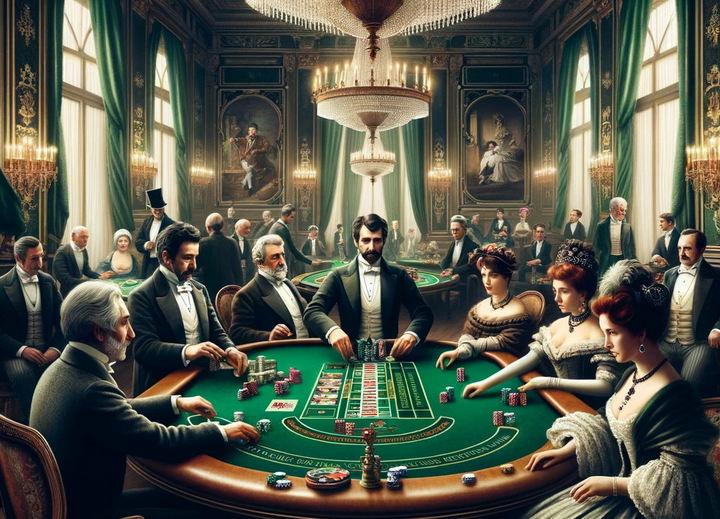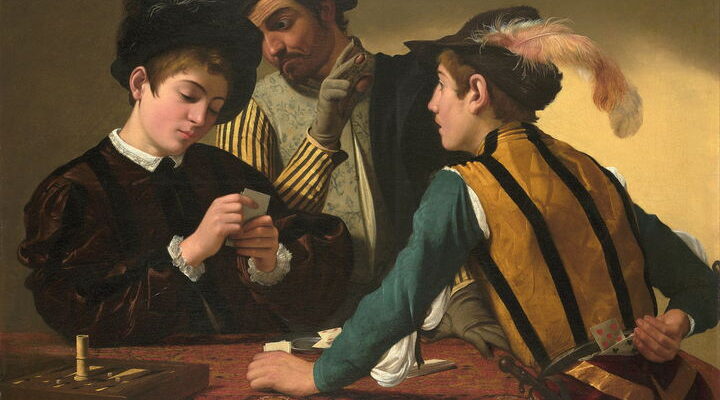Gambling, an activity as old as civilization itself, has been a cornerstone of cultural evolution. Throughout history, humans have bet on outcomes of various events, turning the unknown into a thrilling experience. Ancient bones rolled as dice in prehistoric times set the stage for what would become a multi-billion-dollar industry. From the pottery shards used in ancient China to the sophisticated casinos that now dot the globe, gambling has had a storied journey.
The allure of gambling isn’t merely in the potential windfall. It’s woven into human psychology, a testament to our love for risk and reward. From gladiatorial bouts in Roman times to modern sports betting, the thrill of staking something of value on an unpredictable outcome has resonated through the ages. It’s a narrative that has unfolded across countless cultures and epochs. And it’s one that continues to captivate us to this day.
In this narrative, we’ll delve into historical facts about gambling that have been both catalysts for cultural change and reflections of the societies that embraced them. Expect to uncover the roots of popular casino games and learn how sometimes the most awkward gambling games managed to leave an indelible mark on history.
But beyond mere facts, these tidbits are windows into the soul of humanity’s quest for excitement, a panorama of our collective psyche throughout the centuries. We stand on the precipice of a vast mosaic of tales, eager to unravel the history of gambling addiction and triumphs. So, before we lay our cards on the table, let’s shuffle through the annals of history to introduce “10 Most Interesting Historical Facts About Gambling.”
10 – The Evolution of Blackjack: From “Vingt-Un” to Vegas
The history of blackjack offers a fascinating glimpse into the cultural interplay of gambling over the centuries. The game, as we know it today, has its roots nestled in the French game “vingt-un,” or “twenty-one,” popularized during the 16th century. This progenitor of blackjack was itself a derivative of other card games of the era, which were played by the aristocracy as a pastime.
As “vingt-un” crossed borders and oceans, it morphed in both rule and form. When it reached the American shore, gambling houses eager to attract players implemented a variety of bonuses, including a 10-to-1 payout if a player’s hand included the ace of spades and a black jack. This hand was colloquially referred to as “blackjack,” a name which stuck and overshadowed its original title.
The game’s transformation continued through the 20th century as it became formalized in casinos. Mathematicians and strategists, most notably the Four Horsemen of Aberdeen who applied rigorous statistical analysis to the game, uncovered that, unlike many games of chance, blackjack offered a potential edge to the player. This analytical approach spawned books and systems, turning blackjack into a cerebral contest between player and dealer.
Today, blackjack remains a casino mainstay, an emblematic symbol of the blend of chance, strategy, and social interaction that many find irresistible in casino gaming. It is a testament to the enduring appeal and adaptability of card games within the gambling realm.
09 – When FedEx Bet on Blackjack
In an extraordinary tale of entrepreneurial survival, FedEx, the global courier delivery services company, owes its existence to the gambling spirit. In the early 1970s, FedEx founder Frederick W. Smith took the company’s last $5,000 to a blackjack table in Las Vegas, desperately attempting to keep the company afloat. The gamble paid off, and the winnings were substantial enough to cover the cost of fueling their planes and keeping the operations running.
This remarkable story is not just a trivia footnote; it exemplifies the high stakes risks that businesses occasionally must take. Smith’s unorthodox strategy underscores a larger narrative where the brinkmanship and decision-making inherent in gambling can crossover into the business world. FedEx’s success story is now part of the entrepreneurial folklore and a compelling case study in risk management.
The FedEx anecdote also highlights a broader theme within the world of gambling. Sometimes, the biggest gambles aren’t taken in casinos, but in the boardrooms and on the precipice of potential business failure.

08 – Monte Carlo’s Dichotomy: A Gambling Paradise with a Local Ban
Monte Carlo is synonymous with luxury gambling, attracting the global elite to its opulent casino floors. Yet, in an ironic twist, the citizens of Monaco are prohibited from participating in the gambling activities their city is famous for. This prohibition has been in place since the mid-19th century when the principality’s royal family, the House of Grimaldi, decided to protect its subjects from the potential perils of gambling.
This regulation created a dichotomy within Monte Carlo. It is both a celebrated center for international gambling tourism and a place where locals must observe the glitz and glamour from a distance. Initially aimed at rescuing the House of Grimaldi from financial distress, the casino has risen to an international emblem of high-stakes play. Remarkably, it remains off-limits to the residents who live in its shadow.
The ban is a rare instance of a government protecting its citizens from the possible negative consequences of gambling, such as addiction and financial ruin, by creating an enclave for foreigners alone. This policy has cemented Monte Carlo’s reputation as a playground for the affluent, a status that continues to thrive amidst the principality’s wealth and charm.
This unique approach to local gambling laws not only reflects Monte Carlo’s commitment to responsible gambling but also enhances its allure as an exclusive gambling destination, reserved for those who travel to its shores in pursuit of fortune.
07 – A New Era in Vegas: The First Native American-Owned Resort
The ever-evolving landscape of Las Vegas welcomed a groundbreaking development when the first resort fully owned and operated by a Native American tribe opened its doors. This milestone signifies a pivotal shift in the gaming industry, as indigenous groups have long been associated with casinos on their own sovereign lands but had not yet breached the heart of the gambling capital — Las Vegas.
The opening of this resort was more than a business venture; it represented a cultural and economic triumph. The resort blends the lavishness of Vegas with the heritage and traditions of the tribe, offering a unique experience that differentiates it from other properties on the Strip. This endeavor reflects a broader trend of empowerment and self-reliance within Native American communities, with revenues being channeled back into education, healthcare, and community development.
The establishment of this resort not only diversifies the entertainment options in Las Vegas but also serves as a tangible representation of the resilience and entrepreneurial spirit of Native American tribes in the modern economic landscape.
06 – The Birth of the One-Armed Bandit in San Francisco
The familiar chime and spin of slot machines have their origins in the late 19th-century San Francisco, where the first slot machine was created. This mechanical innovation, known colloquially as the “one-armed bandit,” revolutionized casual gambling and became a staple in saloons across America.
Developed by Charles Fey, the “Liberty Bell” slot machine was a marvel of its time, enticing players with its simplicity and the thrill of instant cash prizes. Fey’s invention laid the groundwork for the modern slot gaming industry, which would evolve to include various themes, multiple paylines, and digital technology. These machines provided an entry point for a wider demographic into the world of gambling, as they required no particular skill set or gambling knowledge.
Today, slot machines are an integral part of the casino experience, generating significant portions of casinos’ revenue and continuing to captivate players with their flashing lights and potential for jackpot glory. They symbolize the chance for fortune that is the cornerstone of the casino experience.
05 – The Royal Legacy of The National Lottery
Dating back nearly half a millennium, the National Lottery was introduced by Queen Elizabeth I to raise funds for “the repair of the havens and strength of the realm.” This early form of the lottery was an ingenious solution to finance public projects without further taxing the citizens. It not only set a precedent for government-run gambling but also showcased the monarchy’s initiative in resource mobilization.
The historical introduction of the National Lottery offers insight into the long-standing relationship between gambling and societal development. As one of the earliest forms of organized gambling, it paved the way for future government-sanctioned lotteries that would support public works, education, and arts programs.
The legacy of Queen Elizabeth I’s lottery is felt today in the countless lottery programs worldwide that contribute to good causes. It demonstrates the enduring appeal of gambling as a means of collective benefit, extending beyond individual gain to support broader societal advancements. This historical fact underscores the intricate ways in which gambling has been interwoven with governance and public welfare.
04 – The Wheels of Fortune: Roulette’s Rich History
The iconic spinning wheel of roulette, a symbol of chance and opulence, has a storied past that begins in 18th-century France. Derived from the older games of hoca and portique, roulette’s first mention under its current moniker was in a 1716 Bordeaux document, marking the inception of what would become a casino mainstay. The game, whose name means “little wheel” in French, quickly gained notoriety for its simplistic yet captivating gameplay and potential for high stakes.
Roulette’s journey from novelty to casino staple is as intriguing as the game itself. Originally a fusion of various wheel-based games, it was the French who elevated roulette to its current prestige. It was in the fabled casinos of Paris where roulette’s modern layout was refined, including the addition of the zero to give the house its edge. The game flourished across Europe and then traveled across the Atlantic, where it would eventually split into two main versions. The single-zero European roulette and the double-zero American roulette.
The evolution of roulette is a testament to the gambling world’s capacity for innovation and adaptation, reflecting broader shifts in cultural and leisure activities throughout the centuries. Today, it remains one of the most engaging and sophisticated casino offerings, continuing to charm players with its blend of strategy and chance.

03 – Baccarat: A Game of Aristocratic Ancestry
Baccarat, now accessible to any casino visitor, began over half a millennium ago as an exclusive pastime for the upper crust. This card game’s origins are shrouded in the allure of European nobility and aristocrats, where it was savored for its elegance and air of mystique. Unlike more public gambling activities of the era, baccarat’s intimate playing environment contributed to its elite status.
Over time, baccarat’s exclusivity waned, allowing it to spread beyond the gilded walls of aristocratic salons and into the casino mainstream. Its simplistic rules and fast-paced play made it a hit, especially in regions like Asia, where it dominates the gambling scene today. Baccarat’s history reflects the democratization of casino games, from aristocratic beginnings to a popular favorite, underscoring the dynamic nature of gambling culture.
02 – The Far-Reaching Heritage of Playing Cards
The origin of playing cards is as mysterious as it is ancient, with the earliest historical evidence pointing to China before AD 1800. These rudimentary cards were not only for amusement but also represented a cultural exchange of ideas and artistry. The game’s migration from East to West embodies a tale of cultural interaction, as the cards adapted to different societies, gaining unique symbols and suits reflecting various regions and classes.
Through the Silk Road and beyond, playing cards were a form of social currency, spreading across continents and evolving into the familiar 52-card deck we recognize today. Their impact on gambling is indelible, giving rise to countless card games and establishing a universal language of leisure that transcends borders.
The historical significance of playing cards is monumental, serving as a chronicle of human leisure and interaction. Their evolution is a mirror to history, showing how a simple game can interweave with the social and cultural fabric of societies, leaving a legacy that resonates in the shuffled decks of casinos and household card games across the globe.
01 – King Henry VIII’s Royal Gamble
King Henry VIII of England, notorious for his six marriages and a tumultuous reign, was also a fervent gambler. His love for gaming was not merely a pastime but an impassioned endeavor, so much so that he reportedly lost the bells of St. Paul’s Church on a bet. His high-stakes wagers were not limited to money. He also gambled palace fixtures and royal appointments. Henry’s gambling was emblematic of the Tudor court’s extravagance and mirrored the monarch’s broader attitude towards risk and reward.
The King’s gambling exploits provide a fascinating glimpse into the leisurely pursuits of the Tudor era’s upper echelons. His penchant for dice and card games was a luxury that only those of his stature could indulge in with such fervor. The royal court was a hotbed for gambling, with courtiers and visiting dignitaries often engaging in games of chance as a form of socializing and political maneuvering.
Henry’s legacy in gambling also left a mark on the legal landscape of England. His reign saw the enactment of several gambling laws, as the King sought to curb the gambling excesses that he himself indulged in, recognizing the need to protect the wealth and productivity of his subjects. This duality of the King as both a devoted gambler and a regulator adds a rich layer to the historical narrative of gambling.
This illustrious figure’s relationship with gambling underscores a timeless human attraction to the thrill of chance. A theme that resonates through the annals of gambling history. King Henry VIII’s story enriches the tapestry of gambling lore, adding royal flair to the universal saga of chance and fortune.
The Psychology Behind the Thrill
Why is gambling so gripping that it makes even the most rational individuals return to the table? It’s a cocktail of psychological intricacies. When we gamble, we stimulate the brain’s reward system, producing an adrenaline rush and the ‘high’ associated with potential wins. It’s a sensation that can become intoxicating, propelling gamblers back for more.
As for the question of deceit, it’s twofold. The dopamine rush from gambling can lead to a state where the line between fact and fiction blurs for the gambler. Additionally, the stigma surrounding gambling losses can drive gamblers to mask their behaviors. In a dance with destiny, the gambler wears a mask of nonchalance, even when the stakes are high and losses loom large.
The paradox of gambling is that it offers both the risk of loss and the possibility of gain, and in that duality lies the enigma of its enjoyment. Even in the face of defeat, a gambler may find a strange solace, a confirmation of the daring leap taken. This relationship with loss is complex, tied to the innate human fascination with the unpredictable.
In exploring these enigmas, we’ve traversed the landscape of what makes gambling an enduring piece of the human experience. We’ve seen how it mirrors our deepest desires and fears, and how it remains a testament to our inherent need for excitement and the allure of the unknown. From this understanding springs the opportunity to appreciate gambling not only as a pursuit of material gain but as a reflection of our human nature.
The Rise of the Desert Oasis – How Las Vegas Became a Gambling Mecca
Las Vegas stands as a beacon of neon lights in the desert, a testament to the human desire for leisure and luck. The story of how this oasis became synonymous with gambling is a narrative of audacity and, perhaps, inevitability. It’s a journey that began with a railway stop and bloomed into the world’s premier gambling destination.
The city’s origins are humble, rooted in the construction of the Hoover Dam and the legalization of gambling in Nevada in the 1930s. But it wasn’t until the post-war boom and the involvement of organized crime that Las Vegas truly began to flourish. Visionaries saw the potential of this arid land, building resorts and casinos that promised glamour and luxury amidst the stark desert backdrop.
Las Vegas’s evolution is famous with iconic establishments and larger-than-life personalities who bet big on its success. Their gambles paid off spectacularly, creating a city that epitomized the American Dream’s most extravagant possibilities. It’s a locale that has witnessed some of the most fascinating concert halls and ostentatious displays of opulence in history.
This story, rich with ambition and drama, chronicles the transformation of a desolate valley into a symbol of fortune-seeking. As we pull back the curtain on Las Vegas’s ascension, we lay bare a saga of resilience, reinvention, and the relentless pursuit of a gamble worth taking. Indeed, this chapter in the history of gambling encapsulates the spirit of an industry that thrives on the allure of possibility.


